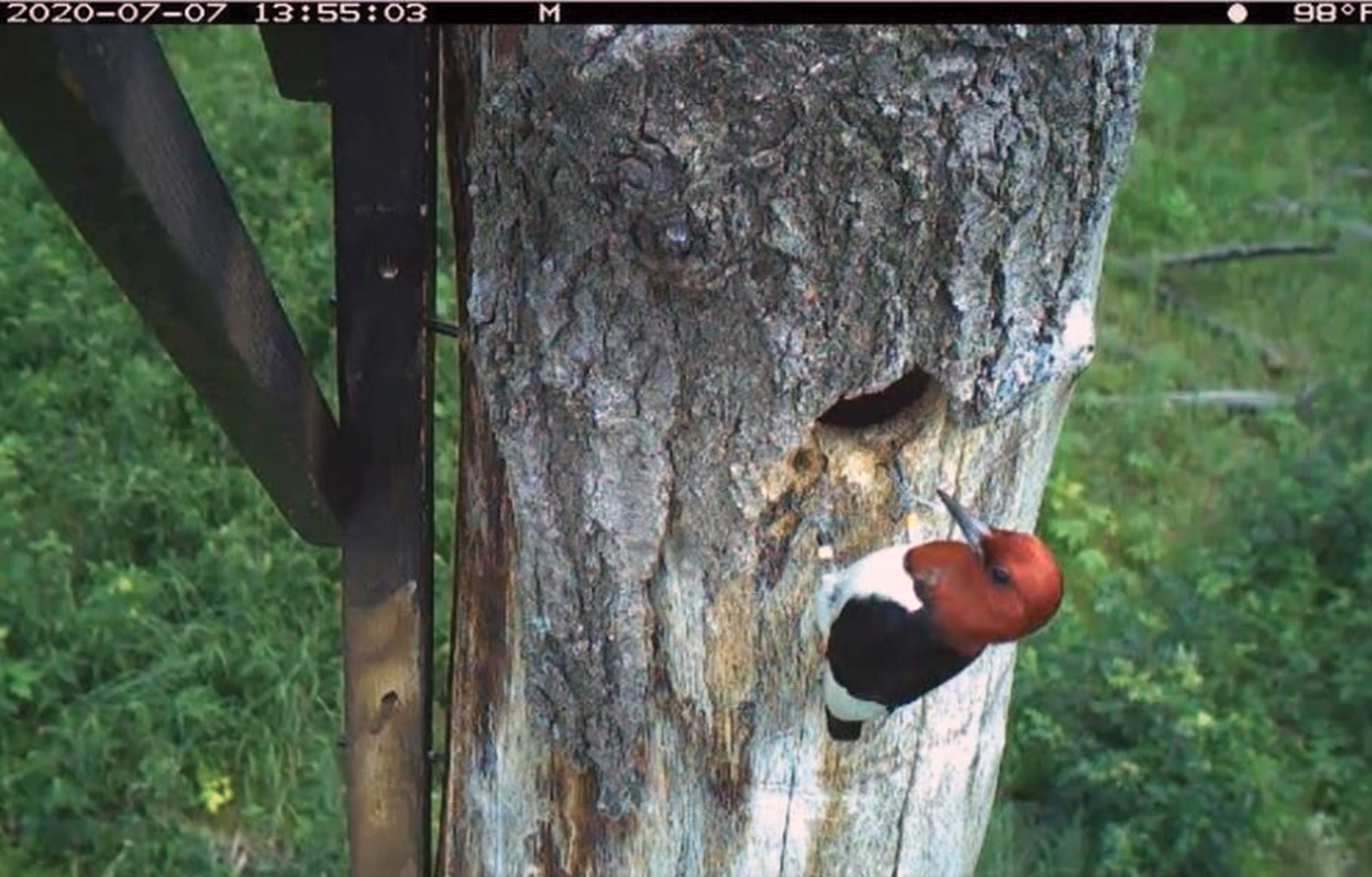citizen science
The Woodpecker Cavity Cam Project
Science Scope—January/February 2022 (Volume 45, Issue 3)
By Jill Nugent
Red-headed woodpeckers (Melanerpes erythrocephalus) are boldly colored, medium-size woodpeckers that are native to North America. Although the species was once considered common, the woodpecker’s numbers have declined over the last 50 years, namely due to habitat loss. Conservation efforts are underway to help restore the species, and the Woodpecker Cavity Cam Project invites you to play a role in the overall conservation success story by participating in cutting-edge, real-world research.
The Woodpecker Cavity Cam Project study site is based at the Cedar Creek Ecosystem Science Reserve in Eastern Minnesota (see “Study site”). The research site features the oak savanna habitat and is home to over 100 breeding red-headed woodpecker adults each year. Researchers have deployed nest cavity cams at this location to study the woodpeckers and life at the cavity nest sites (see Figure 1). Red-headed woodpeckers nest (and roost) in tree cavities, and they have also been observed using wood utility poles in places where their preferred native habitat is lacking. The woodpeckers are considered primary cavity nesters, meaning that they excavate and create the openings in trees that they use as habitat. Many other animal species such as squirrels, bats, and other birds (i.e., chickadees and nuthatches) also use the holes. Animals such as these are considered secondary cavity dwellers. Secondary cavity users do not build or create openings, but rather depend on other species such as the red-headed woodpeckers to excavate the holes.

Red-headed woodpeckers can be fierce defenders of their territory; however, much is still unknown about their behavior and interactions at the nest cavity site. The Woodpecker Cavity Cam Project is designed to help fill gaps in the understanding of this species. The cavity cam videos recorded at the field site in Minnesota are shared on the Zooniverse platform so that anyone with an internet connection can participate in this exciting, real-world research (see “Project home”).
Project goal: To study animal interactions at red-headed woodpecker nest cavities
Your task: Identify animals and observe animal behavior in videos from trail cams
Science discipline: Life and Environmental Science
In this project, students will observe these amazing woodpeckers in their natural habitat, as they help to advance current understanding of red-headed woodpeckers (see “Research page”). To get started, visit the project home website (see “Project home”). If you would like, you can create a free account and also view a helpful getting-started tutorial to see an overview of the project tasks. An online field guide is accessible from the project page and is available for quick reference. There are three aspects to the online project, and they include (1) identifying animals that are present on the cavity cam video clips, (2) documenting behavior observed, and (3) providing insights related to specific banded red-headed woodpecker individuals that may appear. Any and all participation is welcome; the project home page provides information on each of the three aspects (which the project calls workflows).
Students will enjoy viewing the cavity cam video clips, identifying animals that are present in the clips, as well as observing interactions and behaviors that are seen on the videos. For example, your students may see squirrel predation attempts at the nest site, interactions among red-headed woodpecker parents and their offspring, food deliveries (i.e., insects and nuts) to the nest site, and more! Participation in the project advances a greater understanding of red-headed woodpeckers, especially relating to the habitat that supports nest success and survival. After viewing the cavity cam video clips, students may be able to generate additional questions as their curiosity is sparked.
Materials you will need:
- A computer (or device) with internet access
The project provides an array of educational resources that are available online for teachers and students. The resources were developed in 2021 by Minnesota Master Naturalists and volunteers (see “Project education page”). Free downloadable activities, games, quizzes, presentations, and more are available for the classroom. The resources facilitate extended exploration into the project topic and help to supplement the overall learning experience.
Immersion in the project and its educational activities will provide students with authentic science experience as they address research questions relating to nesting behaviors, competition, influences of nest success, predation, and more—while also adding to a greater understanding of red-headed woodpeckers and their important role in the environment. •
Woodpecker Cavity Cam Project at a glance
When: Anytime
How: Visit the project home (see “Project home”) to get started and begin classifying what you observe.
Where: Online
Time needed: 5 minutes (or as often as you like!)
Special equipment needed: None
Cost: Free
Contact for more information: Visit the Project’s talk page: https://www.zooniverse.org/projects/elwest/woodpecker-cavity-cam/talk
Safety: As with any science lab, classroom, or field activity, always ensure that you are following recommended safety practices; for more information on safety in the science classroom, visit www.nsta.org/safety.
Helpful Project Links
Project home—https://www.zooniverse.org/projects/elwest/woodpecker-cavity-cam
Project education page—https://www.zooniverse.org/projects/elwest/woodpecker-cavity-cam/about/education
Project link on SciStarter—https://scistarter.org/woodpecker-cavity-cam
Research page—https://www.zooniverse.org/projects/elwest/woodpecker-cavity-cam/about/research
Study site—https://www.cedarcreek.umn.edu/
Jill Nugent (jillfnugent@gmail.com) teaches science online, engages educators in citizen science experiences for the classroom, schoolyard, and beyond, and serves on the SciStarter Team. Follow SciStarter on Twitter: @SciStarter. This column is the result of a partnership between SciStarter and the National Science Teaching Association. For more information about SciStarter and other citizen science projects, please visit www.scistarter.org.
Biology Citizen Science Instructional Materials Technology Middle School


